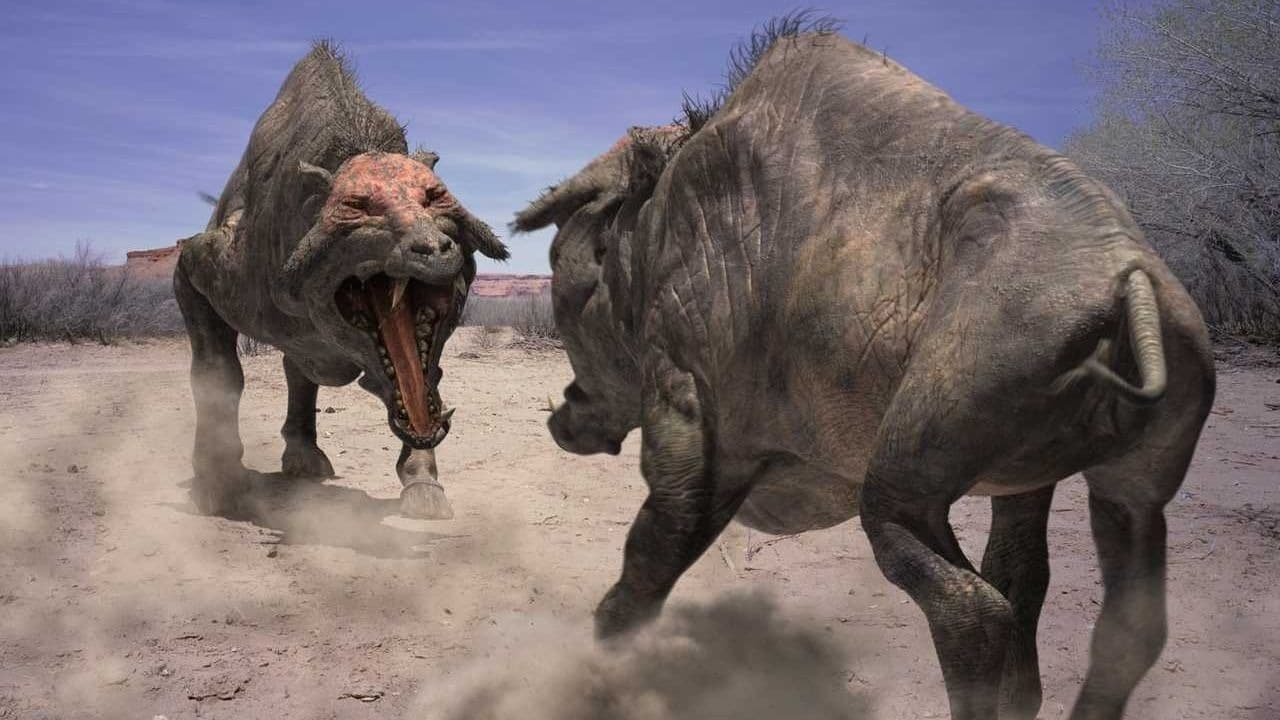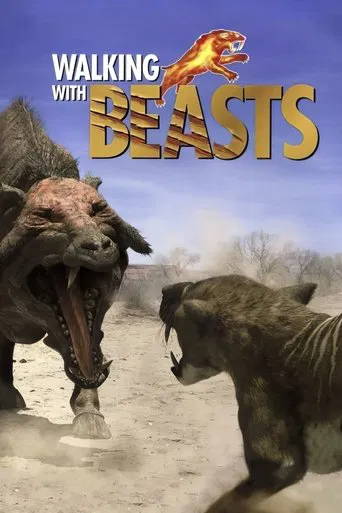

...but I'm biased, not only because I love this subject but because a full-length documentary exploring the vast subject of the Cenozoic era was long overdue. I mean come-on! We currently live in a mammalian world with only 4 surviving orders of reptiles, all of which barely come into contact with everyday human beings. Mammals rule the ocean...they're the biggest, smartest and even the most ferocious (killer and sperm whales). How did all this come to be? The story is told in Walking with Beasts. Indeed it can be said that Walking with Dinosaurs is about interest, while Walking with Beasts is about legacy!The era is covered in 6 six half-hour episodes, which is about as long as any such programme can hope to be. In geological terms, we have depictions of the early Eocene, late Eocene, Oligocene, Pliocene, early Pleistocene, and late Pleistocene. OK, excluding the boring Holocene...heh...we're missing two epochs (Paleocene and Miocene) which might seem less agreeable...why not do one for each??? Still one finds the amount of information covered in the programme sufficient and of course interesting. I personally wouldn't want to have missed any of them out.Briefly, in "New Dawn" we get Leptictidium, Propalaeotherium and Ambulocetus, the latter (I'm sure a lot of you are aware) is known for its role in the evolution of the whale. The 6 foot bird Gastornis is another highlight. Forget about the ostrich, this guy was a predator and at the top of the food chain. "Whale Killer" is a follow-up centering on Basilosaurus and its survival in the late Eocene Tethys Sea (the climate change alludes to the end of the Eocene). "Land of Giants" is mainly about the giant Indricotherium (this guy was bigger than T-Rex) and Entelodont, a feisty animal related to pigs. Australopithecus was the star of the episode "Next of Kin" which also features Deinotherium. My Favorite was "Sabre tooth", which features Smilodon, the terror bird Phorusrhacos, and Megatherium, the giant sloth. Lastly, "Mammoth Journey" is complete change of climate. It depicts the ice-age inhabitants Megaloceras, wholly rhino and the mammoth...They are all incredible animals and very realistic. You can tell that the CG was slightly better than that used for "Walking with Dinosaurs". The creation of realistic fur and feather presented a huge challenge for the team. In short, it has everything its predecessor has. Perhaps a real treat included in the DVD are the two full-length "making of..." programmes. They provide an in-depth scientific discussion of each of the subjects in the series, including a look at the fossils from the Messil pit in Germany, which provided the basis for the "New Dawn". There were also experts on each specific subject. This gave me the impression that the programme was very well-researched, and perhaps better researched than it predecessor, a claim also made by the producers.I remember reading, either from amazon or here, that the bbc can't make documentaries. I can't disagree more with this statement. I've been watching their documentaries since I was a kid, and I've always liked their "assume an intelligent public" and "broadcast even though people care more about Big Brother" approach to documentaries. This is exactly the kind of thing that gives rise to documentaries like Blue Planet, Horizon and Planet Earth. It's a tradition the bbc should be proud of....
... View MoreEven has some humans in it, but none resembling Raquel Welch, nor the phony language.It's a live-action documentary in six parts, ranging from the meteor that extirpated the dinosaurs up to the Ice Ages. The Cenozoic Era, largely overlooked, but most important in shaping today's fauna (including us!)--much more relevant than The Big Show that was the dinosaur period.The most interesting sequences are on the giant animals of South America, the development of whales, and the battles for control of land between the survivors of the apocalypse at the end of the Cretaceous period (parts 5, 2, and 1, if I remember correctly).This was produced by the BBC, following its big success with Walking with Dinosaurs. It's got the same mix of imagined local filmed drama, a la Wild Kingdom, with some basic paleontological exposition. The live action stuff is mostly realistic and there seems to have been considerable research on the backdrop. Each part is based on the fossil records of a particular location. I doubt this sequel was such a big hit, but for the reasons I've suggested above (and the general unfamiliarity of what you'll see), probably more valuable and educational.
... View MoreLacking cable, I was unable to see "Walking with Prehistoric Beasts" when it premiered last December on the Discovery Channel. Therefore, I had to wait impatiently until February 2002 to purchase the DVD set. My anxious wait was not in vain. "Prehistoric Beasts" is awe-inspiring, provocative, informative, and ambitious, very nearly the equal of its precedessor "Walking with Dinosaurs". The scientific knowledge, care, production, and preparation the BBC crew expended on this program was well invested and deeply appreciated, at least by this paleontology buff. I've watched the "episode" DVD and "making of" DVD at least three times already. I will never get tired of it.Why a shade below "Dinosaurs"? Well, dinosaurs have a unique marquee appeal all their own - they are truly exotic, mysterious, and alien. While the creatures featured in "Beasts" were all special and impressive - from the forest ants and hopping Leptictidium to the titanic Indricotherium - they're still just a tad too familiar. Nonetheless, I enjoyed all six episodes for their professionalism, information, and naturalism (except for some self-conscious camera work, as for example when the indricothere calf knocks over a camera and a mammoth sprays mud on another one - which I actually found amusing). The CGI and animatronic work was phenomenal for the most part, especially in the mammoth sequences - they seemed just like living hairy elephants. Only some of the renditions - like the Smilodon kittens and a couple of the Australopithecines- seemed just a tad artificial. But that is definitely a minor quibble. Also, digitizing out the mating Australopithecines was a bit distracting. As with the mating stegosaurs in "When Dinosaurs Roamed America", they should have just cut away before the deed was consummated.My favorite episodes were the "indricothere" and "woolly mammoth" ones, because I am a sucker for giant mammals (megafauna). It's a shame these creatures aren't still with us. Some, like the megatherium, doedicurus, and mammoth, were alive only a few thousand years ago!To those who did not enjoy the "Walking.." series because it is based on speculation and conjecture, I say, suspend your disbelief and savor the daring and original attempts to re-create a lost world based on the most up-to-date information. It is so well-rendered that if it didn't actually occur that way eons ago, it should have!Again, kudos to the BBC for both "Walking.." series and their accompanying books (which I also own). I recommend they continue this paleontological quest; they are many more prehistoric beasts to feature!Out of 10, I would rate "Walking with Prehistoric Beasts" a 9.5!
... View MoreTim Haines made a real misstep in this sequel to Walking With Dinosaurs, in that he made the doc too much of a story, and not enough of a documentary. The smilodon segment, especially, seemed contrived, with the two "brothers" and a lone warrior smilodon named "Half-Tooth." They also take too many great pains to have the animals reacting to the camera. On the other hand, the evolution of man is nicely done - and I strong recommend the Discovery Channel documentary Neanderthal as a companion piece.Speaking of Discovery, once again they make a hash of the documentary, editing out the rougher scenes, and intercutting the Making Of... into it as well. Stockard Channing sounds robotic as the narrator as well. I strongly suggest getting the DVD, which retains all the BBC UK stuff intact.
... View More